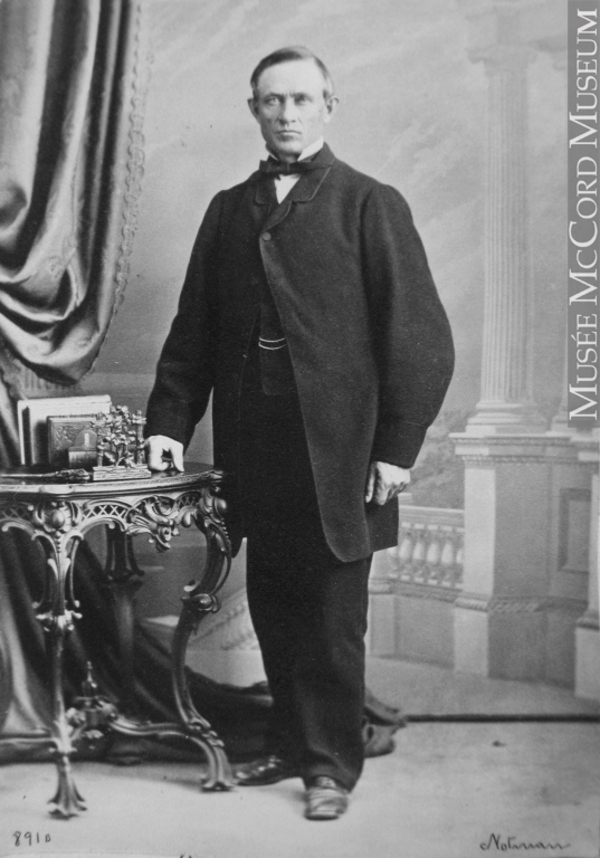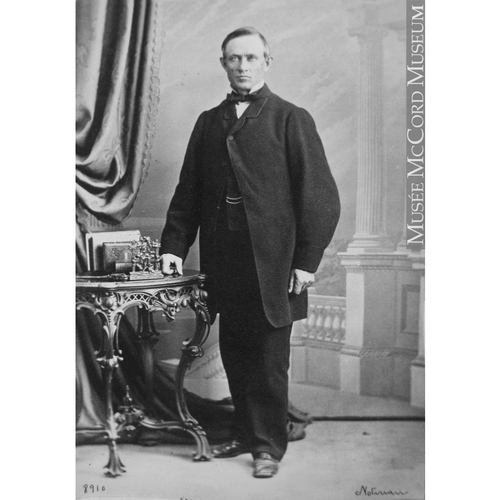
Source: Link
MACLAREN, JAMES, businessman; b. 19 March 1818 in Glasgow, son of David MacLaren and Elizabeth Barnet; m. 13 Jan. 1847 Ann Sully; and they had 13 children; d. 10 Feb. 1892 in Buckingham, Que.
James Maclaren came to Upper Canada in 1822 when his father gave up his hardware trade in Glasgow to settle in Richmond. The family later moved to Torbolton Township on the Ottawa River, where David MacLaren cleared a small farm and became involved in township affairs. The family moved to Wakefield, Lower Canada, in the 1840s and James entered into business late in the decade with his brother David, forming James Maclaren and Company. Borrowing money from his father, James developed a diversified business – a general store, gristmill, woollen mill, and brick-making plant – which was successful enough to allow him to repay his father’s estate. Increasingly he became involved in buying white-pine logs and timber on the Rivière Gatineau, some of which he sold to the sawmills at New Edinburgh (Ottawa).
This involvement in lumber led Maclaren in 1853 to form another early partnership, an association that set a pattern for his future activities. Along with Joseph Merrill Currier*, Richard William Scott*, and Moss Kent Dickinson, he leased a large sawmill at New Edinburgh from Thomas McKay*. Over the next few years Maclaren, assisted by his brother John, who replaced David in the Maclaren company about 1861, was able to buy out Dickinson, Scott, and Currier. In 1866 the company purchased the New Edinburgh Mills from the McKay estate for $82,000. The firm was doing well enough to retire its $61,500 mortgage in little more than three years. In 1871 the sawmill employed 53 hands and produced lumber valued at $150,000 a year, while a smaller sash factory employed another 20 men and produced goods worth $20,000. The sawmill and some lots in Ottawa, purchased with the assistance of Sir John A. Macdonald, were eventually sold in 1894, two years after James’s death, for $340,000.
James Maclaren was described in 1857 by an agent for R. G. Dun and Company as an energetic, smart businessman of “excellent char[acter],” a man who took care of every affair and who was in “good standing” in Wakefield. These characteristics allowed his lumbering concerns not only to survive the drop in the lumber and money markets at the start of the American Civil War but to expand. In 1864 Maclaren put together a partnership to purchase from the estate of Baxter Bowman the sawmills and industrial complex at Buckingham, on the Rivière du Lièvre. Maclaren’s partners were J. M. Currier; William McNaughton, a Montreal forwarder and trader; Jacques-Félix Sincennes* of Sorel; and James’s brother John. In 1871 James brought his eldest son, David, into the business and three years later placed him in charge of the Gatineau and Ottawa River branches. In 1872 James bought out all his partners in the Buckingham mills except John and, following John’s death in 1875, he purchased his share as well. He also bought his brother’s interests in James Maclaren and Company at Wakefield and Ottawa and, at New Edinburgh, in W. McClymont and Company, lumber merchants, and Blackburn and Company, manufacturers of woollen stuffs and cloth.
Despite this growing diversification, Maclaren’s business was centred at Buckingham. Both as a leading employer of townsmen and as a benefactor, he played a major role in its development. Resisting pressures in the 1880s to relocate to Ottawa, he preferred to remain at Pinehurst, the family home, which he had built overlooking the Lièvre at Dufferin Falls. At Maclaren’s death in 1892 about 500 men in a town of 3,500 were employed in the lumber business, and no labour dispute had yet occurred. James Maclaren and Company and J. R. Booth and Company were the two firms “that survived longest cutting deals for the English market,” according to historian Arthur Reginald Marsden Lower*, but by the late 1870s Maclaren’s was regularly exporting large barge-loads of lumber to Montreal and the New York urban area.
To facilitate business operations further, James Maclaren was the prime mover behind the founding of the lumber-oriented Bank of Ottawa in 1874. His subscription of $100,000 to its capital stock amounted to nearly one-third of the paid-up capital at the end of 1875 and made it possible for the bank to obtain the balance of the capital easily. Though Maclaren served as president of the bank until his death, it was but one of his expanding interests in the 1870s and 1880s. A founding director in 1880 of the Hull Iron Company Limited in Quebec, he was also involved in iron-mining in Hastings County, Ont., and in salt-and silver-mines in the southwestern part of the province. He was a vice-president and director of the Ontario Central Railway, which failed in its intention to build from Whitby to Collingwood, and was a member of a syndicate that bid unsuccessfully in early 1881 to construct a transcontinental line. Maclaren met greater successes in his own field: he invested in lumbering businesses in Vermont and Massachusetts, and was the founding vice-president of Sheppard and Morse Lumber Company of Boston. Like other prominent Ottawa valley lumbermen, he moved into the Timiskaming and Georgian Bay regions, becoming president of two companies in Saginaw, Mich.: the Saginaw Lumber and Salt Company and the Emery Lumber Company, which maintained a sawmill in Midland, Ont. In 1885 he was a member of the newly incorporated Buckingham Pulp Company Limited.
By the late 1880s Maclaren had accumulated one of the largest fortunes in Canada and was preparing for a major expansion westwards, following the railways. In 1887 he and James Gibb Ross*, a Quebec City capitalist, visited British Columbia to assess investment possibilities there. Convinced of the opportunity offered by the west coast, Maclaren set up two firms. The Ross-Maclaren Lumber Company was originally designed to hold licences on timber limits comprising some 100,000 acres in the Fraser valley and on the eastern shores of Vancouver Island and to sell or supply timber to the second company, the North Pacific Lumber Company, incorporated in 1889 with a capital of $100,000. The directors of the North Pacific were Maclaren, John Theodore Ross* (a nephew of J. G. Ross, who had died in 1888), a Mr Little (possibly William Little, the Montreal lumberman), and two of Maclaren’s sons, David and James Barnet. The company built beside the Canadian Pacific Railway tracks at Barnet, nine miles east of Vancouver. The Ross-Maclaren company, in order to meet provincial requirements, built a mill at Millside, at Fraser Mills, east of New Westminster. By 1891 it was in operation with an output of 200,000 feet of lumber a day. Plans to supply the mill by constructing a railway from the Fraser to Maclaren’s Cultus Lake timber limits had been drawn up and a survey begun just prior to Maclaren’s death in February 1892. That event, and a lumber recession, caused the scheme to be abandoned.
At the time of his death Maclaren’s estate was estimated in an obituary at five million dollars. Under the terms of his will, Maclaren, a staunch Presbyterian, left $20,000 to Manitoba College [see John Mark King] and a similar sum, for the purchase of books, to Knox College in Toronto, where his brother William was a professor of theology. James Maclaren was survived by his wife, two daughters, and five sons, Albert, Alexander, David, James B., and John, all of whom had become involved in the lumber business.
AO, RG 22, ser.224, reg.G (1890–92): 395–406; ser.354, probate 2087. Baker Library, R. G. Dun & Co. credit ledger, Canada, 3: 106; 13: 220. NA, MG 24, D39 (photocopies); MG 26, A, Macdonald to Maclaren, 30 Nov. 1888. Canada Lumberman (Toronto), 12 (1891), no.11 (mfm. at AO). Montreal Daily Star, 11 Feb. 1892. Ottawa Citizen, 11 Oct. 1893. Canada, an encyclopædia (Hopkins), 1: 445. Canadian men and women of the time (Morgan; 1898); (Morgan; 1912). Cyclopædia of Canadian biog. (Rose and Charlesworth), vol.2. Dominion annual reg., 1880–81: 133, 169; 1885: 305. Standard dict. of Canadian biog. (Roberts and Tunnell), vol.1. A. R. M. Lower, Great Britain’s woodyard.: British America and the timber trade, 1763–1867 (Montreal and London, 1973). Donald MacKay, Empire of wood: the MacMillan Bloedel story (Vancouver, 1982), 17. G. W. Taylor, Timber: history of the forest industry in B.C. (Vancouver, 1975), 38. J. W. Thomson, Lumbering on the Rivière du Lièvre (Ottawa, 1973), 38–41.
Cite This Article
Richard M. Reid, “MACLAREN, JAMES,” in Dictionary of Canadian Biography, vol. 12, University of Toronto/Université Laval, 2003–, accessed April 23, 2025, https://www.biographi.ca/en/bio/maclaren_james_12E.html.
The citation above shows the format for footnotes and endnotes according to the Chicago manual of style (16th edition). Information to be used in other citation formats:
| Permalink: | https://www.biographi.ca/en/bio/maclaren_james_12E.html |
| Author of Article: | Richard M. Reid |
| Title of Article: | MACLAREN, JAMES |
| Publication Name: | Dictionary of Canadian Biography, vol. 12 |
| Publisher: | University of Toronto/Université Laval |
| Year of revision: | 1990 |
| Access Date: | April 23, 2025 |



